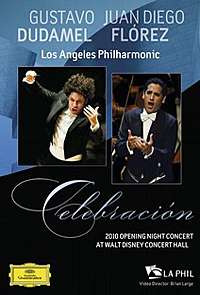|
Back
12/29/2010
Gioacchino Rossini: Overture to La gazza ladra – Recitative and aria "Principe più non sei... Si, ritrovarla io giuro" from La Cenerentola – Overture to Semiramide – Aria "La speranza più soave" from Semiramide
Chabuca Granda: La flor de la canela (arr. J. D. Flórez)
Augustín Lara: Granada
José Pablo Moncayo: Huapango
María Grever: Júrame
Pedro Elías Gutiérrez: Alma ilanera
Arturo Márquez: Danzón No. 2
Juan Diego Flórez (tenor), The Los Angeles Philharmonic Orchestra, Gustavo Dudamel (Conductor), Brian Large (Video Director)
Filmed at the Los Angeles Walt Disney Concert Hall (October 7, 2010) – 100mn
Deutsche Grammophon Ref. #: B0015050-09 – NTSC Colour – Format16/9 – All regions – PCM Stereo – DTS 5.0 – Menu language: English – Subtitles in Italian, Spanish, French, German – Booklet in English and Spanish

Music Director Gustavo Dudamel launched his second season at the helm of the Los Angeles Philharmonic Orchestra with an unconventional program of Rossini's arias and overtures coupled with Latin American music sung by world acclaimed Peruvian tenor Juan Diego Flórez.
The program starts with a rather starched rendition of the overture to The Thieving Magpie, followed by Juan Diego Flórez in Don Ramiro's recitativo and aria "Principe più non sei... Sì, ritrovarla io giuro" from La Cenerentola. Flórez, portraying a passionate and determined prince, is on his turf with this repertoire, and stratospheric notes do not intimidate the Peruvian tenor. The volume is there but the voice still needs warming up and the high notes, indeed not to be questioned, sound a bit metallic. The overture to Semiramide, a mainstay of orchestral literature, is written for a larger orchestra than that of La gazza ladra and fills more appropriately the immense volume of the Disney Hall. Also from Semiramide, Idreno's "La speranza più soave" allows Flórez to demonstrate perfect technique in the fervent coloratura passages, and here again, high notes are incisive and reached with confounding ease. If anything, one could regret that the high register, who used to be so velvety and mellow, now reveals a slight harshness.
With La flor de la canela by Peruvian singer and songwriter Chabuca Grande (1920-1983) we enter the core of the concert with a gripping homage paid to Latin American contemporary, popular, and rarely heard music. Flórez' rendition of this waltz is suave and ardent. The program continues with Mexican songwriter Agustín Lara (1897-1970)'s inevitable and fiery Granada to the delight of the audience. Other numbers include María Grever (1884-1951)'s passionate bolero Júrame, and, in the style of American composer John Philip Souza, with a spirited performance by the Los Angeles Philharmonic of Alma Llanera composed by Venezuelan musician Pedro Elias Gutiérrez (1870-1954). This attractive tribute to Latin American music is brought to an end too soon with Mexican-born composer Arturo Márquez. Márquez, who was inspired by vernacular music, composed several danzones (a Cuban dance). His famous and zesty Danzón No. 2 is a perfect opportunity for Gustavo Dudamel to prove, if need be, that the Los Angeles Philharmonic is versatile and does wonder in non-traditional repertoire, as well. And so does J.D. Flórez.
We return to opera with two encores: the firework display of "Ah mes amis, quel jour de fête!" from Donizetti's La Fille du régiment (in impeccable French), and yet another inevitable piece from Verdi's Rigoletto "La donna è mobile". The audience responds with uncontrolled enthusiasm and, regrettably, cannot wait for the singer and the orchestra to complete their last bar. Will this detestable habit ever disappear from concert halls and opera houses?
Christian Dalzon
|